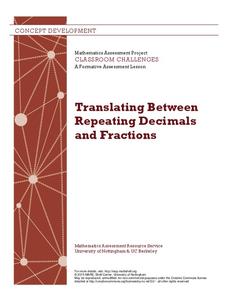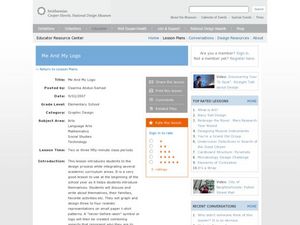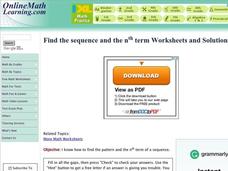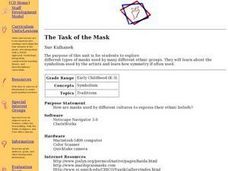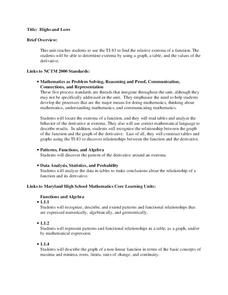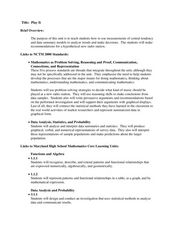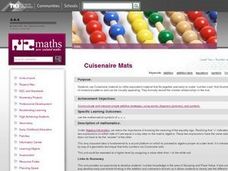Rice University
Calculus Volume 3
See calculus to the end. The eBook is the last of a three-volume series covering college-level calculus topics. Scholars begin with parametric equations and polar coordinates before moving to vectors, finally ending with multi-variable...
Mathematics Assessment Project
Translating Between Repeating Decimals and Fractions
Model for your young mathematicians the process for converting repeating decimals to fractions. To demonstrate their understanding of the process, class members then complete and assessment task and participate in an activity matching...
Curated OER
Me and My Logo
Learners design their own emblem. In this introduction lesson, students get to know one another by designing an emblem that combines symbols that represent themselves. They express themselves to their classmates.
Curated OER
Find the Sequence and the Nth Term
For this online interactive worksheet, 9th graders find the sequence and the next 2 term, the nth term and the 30th term for 12 numeric sequences. Immediate online feedback is provided.
Curated OER
Best lesson in the whole world!
Students study the concept of fraction using mathematical reasoning. In this problem solving fraction lesson, students use various methods to explain their reasoning in solving fractions. Students use a number of different prompts to...
Curated OER
The Task of the Mask
Students discover historical value and use of different African masks through research and literature. Students also relate different customs and traditions of ethnic groups to the masks.
Curated OER
Easy and Artistic Printmaking Using Mixed Media Materials
Students explore printmaking which began with the ancient Chinese who carved seals from stone, inked them and used the seals as identification symbols. They produce a print in this lesson.
Curated OER
Treasure to Ship
Second graders explore and solve an algebraic word problem. They listen to a poem about pirates, describe the word problem in their own words, and independently solve the problem using colored rods to represent the pirates and treasure...
Curated OER
Not So Snappy 4
In this order of operations (i.e., addition, subtraction, multiplication, division) worksheet, students solve 4 word problems demonstrating their understanding of the concept.
Curated OER
Not So Snappy 5
In this order of operations (i.e., addition, subtraction, multiplication, division) worksheet, students solve 5 word problems demonstrating their understanding of the concept.
Curated OER
Properties of Logarithms
Eleventh graders investigate logarithms. In this Algebra II lesson plan, 11th graders explore the properties of logarithms that are used to simplify expression and solve equations. Students confirm their conjectures regarding...
Curated OER
Chart Your Course
Students explore change represented in graphs comparing distance and time. They exchange and share their graphs. Students interpret and create distance versus time line-graphs, and write stories based on these graphs. They interpret a...
Curated OER
Sequences
In this sequences worksheet, student solve 10 different problems that contain various types of sequences. First, they determine the sixth term of the sequence given. Then, 9th graders write the first four terms of a sequence using the...
Missouri Department of Elementary
Are You Balanced?
Balance scales create a strong visual of how an individual prioritizes one's self alongside their commitments to the community, school, and home. Scholars complete a graphic organizer then discuss their findings with their peers. A...
Curated OER
Highs and Lows
Solve problems using integration and derivatives. By using calculus, learners will analyze graphs to find the extrema and change in behavior. They then will identify the end behavior using the derivatives. Activities and handouts are...
Curated OER
Understanding 10: Backwards and Forwards
Help your young mathematicians completely master 10 by practicing one-to-one correspondence, number recognition, and recording numbers displayed. They make 10 with groups of two-different colored cubes and color in 10-frames to show how...
Curated OER
Connecting Formulas Related to Geometric Figures
Students identify diagrams of quadrilaterals and circles by different names and classify the figures. They name the areas for each diagram and practice solving the formulas for each.
Curated OER
Same As
Explore the concept of the equals symbol. In this mathematical symbols activity, learners discover the meaning of the equals sign (symbol). They also construct addition and subtraction sentences to understand the concept of equal parts.
Curated OER
Play It
There are a number of activities here that look at representing data in different ways. One activity, has young data analysts conduct a class survey regarding a new radio station, summarize a data set, and use central tendencies to...
Pennsylvania Department of Education
Problem Solving by Using Multiplication to Solve Division Problems
Students use index cards, counting cubes, and their own understanding to identify how division problems can be solved by using multiplication. In this division lesson plan, students use their multiplication skills to solve division...
Curated OER
Impossible Graphs
Students practice plotting functions on the Cartesian coordinate plane while participating in a discussion about the Possible Or Not worksheet/activity. Students also use the Impossible Graphs worksheet to practice reading a graph,...
Curated OER
Introduction to Statistics: Mean, Median, and Mode
Students explore the concepts of mean, median, and mode. They develop an understanding and familiarity with these concepts. Students explore mean and median in an efficient way. Students explore three different measures of center.
Curated OER
Cuisenaire Mats
First graders use Cuisenaire rods to study the mathematical symbols =, <, > for the relationships is equal to, is less than, and is greater than. They use the rods to show visual explanations of common number combinations.
DK Publishing
Big, Bigger, Biggest
Which water creature is the biggest? Youngsters look at an image of a big shell, then draw a bigger shell next to it. They do the same for a big fish. Next, learners practice with the superlative as they circle the biggest duck and frog....

